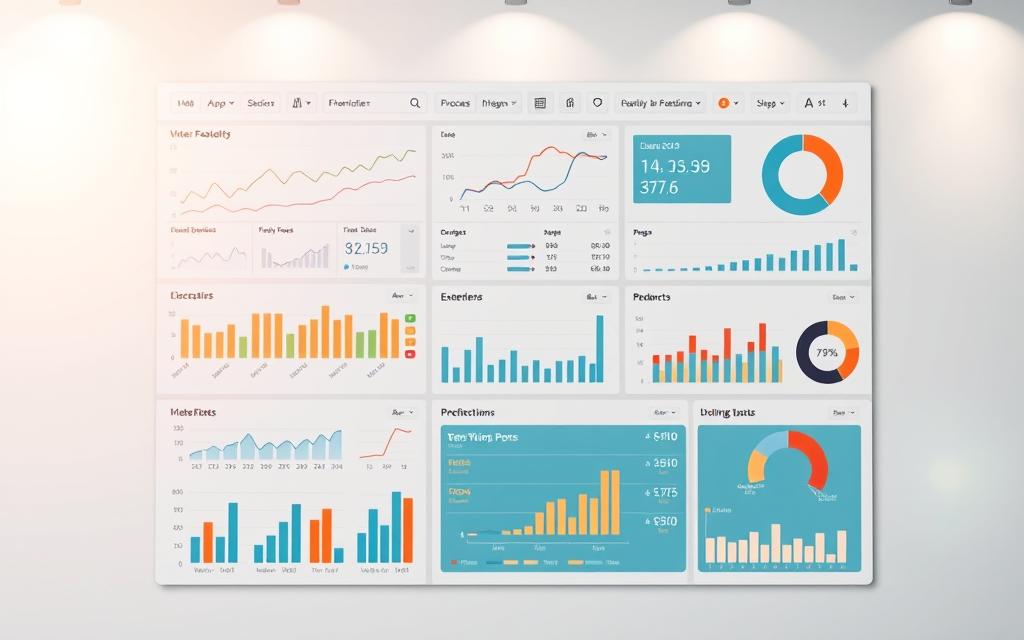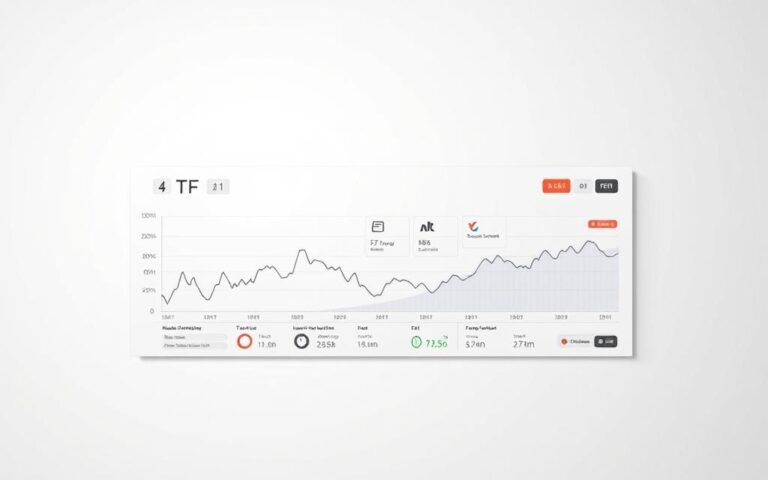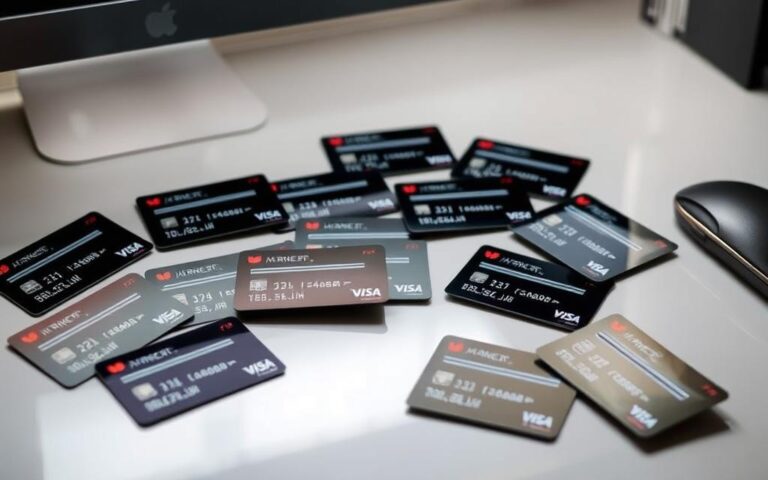Advertisement
Did you know nearly 1 in 5 Americans don’t track their spending? This can lead to overspending and less savings. A financial dashboard can change the game, giving you a clear view of your finances in one spot.
These dashboards use finance data visualization to show your income, expenses, and savings. This makes it easier to understand your financial health. It helps you make smart choices for your future.
Starting with a financial dashboard tool might seem hard, but it’s easier than you think. With a clear view of your finances, you can manage your money better. This way, you can reach your financial goals.
Understanding Financial Dashboard Tools
In today’s fast world, knowing about financial dashboard tools is key for managing money well. These tools give you a full view of your finances. This helps you make smart choices about your money.
What is a Financial Dashboard?
A financial dashboard is a software that brings together financial data from different places into one easy-to-use interface. It shows your financial info clearly, like income, spending, savings, and investments. With a financial dashboard, you can see how you’re doing financially and find ways to get better.

Benefits of Using a Financial Dashboard
Using a financial dashboard has many benefits. Some of the main advantages are:
- Improved Financial Visibility: A financial dashboard gives you a clear view of your finances. It helps you spot trends and patterns you might miss.
- Enhanced Decision-Making: With accurate and current financial info, you can make better choices about your money. This helps you reach your financial goals.
- Increased Productivity: Financial dashboards automate many tasks. This saves you time for more important and valuable activities.
As financial expert, Jean Chatzky, says, “A financial dashboard is like having a personal financial assistant. It helps you stay on top of your finances and reach your goals.” By using financial dashboard tools, you can take charge of your finances and succeed in the long run.
Key Features of Effective Financial Dashboards
Understanding a financial dashboard’s key features can greatly improve your financial decisions. A good financial dashboard is more than numbers; it’s a tool for navigating your finances.
Customization Options
Customization is a critical feature of a financial dashboard. Dashboard design tools let you tailor your dashboard to fit your financial goals. Whether using dashboard templates or starting from scratch, customization is essential.
You might want to track expenses, income, or savings goals. Customizing your dashboard lets you focus on what’s important to you.
Real-Time Data Updates
Another key feature is real-time data updates. This keeps your financial information current, helping you make quick decisions. Real-time updates let you stay on top of your finances, whether it’s daily expenses or investments.
Having up-to-the-minute data means you can act fast on financial changes. This makes managing your finances proactive, not just reactive.
Visualizations and Analytics
Effective financial dashboards also offer visualizations and analytics. These features turn complex financial data into easy-to-understand insights. Visualizations like pie charts and line graphs help you see trends and patterns in your finances.
| Feature | Description | Benefit |
|---|---|---|
| Customization | Tailor your dashboard to your needs | Prioritize relevant financial metrics |
| Real-Time Updates | Stay current with the latest financial data | Make timely financial decisions |
| Visualizations | Transform data into understandable insights | Easily analyze financial trends and patterns |
By using these key features, a financial dashboard becomes a vital tool for managing your finances. It’s essential whether you’re an experienced investor or just starting to track your expenses.
Popular Financial Dashboard Tools in the Market
Interactive dashboards are key in digital finance. They help businesses track their money, make smart choices, and grow.
Quick Overview of Top Tools
Many financial dashboard tools are popular for their features. Here are some of the best:
- Mint: It’s easy to use and tracks your finances well.
- Personal Capital: It helps with financial planning and tracking investments.
- YNAB (You Need a Budget): It’s great for budgeting and managing expenses.
Pricing Comparison
Pricing is important when picking a financial performance dashboard tool. Here’s how the top tools compare:
| Tool | Basic Plan | Premium Plan | Annual Cost |
|---|---|---|---|
| Mint | Free | N/A | $0 |
| Personal Capital | Free | $299/year (Wealth Management) | $0 – $299 |
| YNAB | $6.99/month | N/A | $83.88 |
Knowing what each tool offers helps businesses pick the right one for their needs.
Setting Up Your Financial Dashboard
The first step to clear finances is setting up a detailed financial dashboard. This involves making important choices that shape your financial strategy.
Choosing the Right Software
Picking the right software for your dashboard is key. Look for ease of use, customization options, and integration capabilities with other tools. Business intelligence tools offer various features for different needs, from budgeting to financial analysis.
When picking software, think about:
- User interface and experience
- Availability of customer support
- Scalability and flexibility
- Compatibility with your existing financial systems
Integrating with Bank Accounts and Data Sources
Linking your dashboard with bank accounts and data sources is crucial. This ensures your financial info is current and accurate. It allows for real-time data updates, helping you make informed decisions.
A comparison of different integration options is provided in the table below:
| Integration Option | Features | Security |
|---|---|---|
| Direct Bank Connection | Real-time updates, automatic transaction categorization | High |
| CSV Import | Manual upload, flexible data formatting | Medium |
| API Integration | Customizable, real-time data access | High |
By choosing the right software and linking it with your financial data, you can build a strong financial dashboard. It will give you valuable insights into your financial health.
How to Customize Your Dashboard
A customized financial dashboard can greatly help you manage your money better. It lets you focus on the financial details that are most important to you. This makes your dashboard a key tool in managing your finances.
Selecting Key Metrics to Monitor
To start customizing your dashboard, first pick the financial metrics you want to watch. These could be things like account balances, how much you spend, how much you earn, or your savings goals. Picking these metrics helps your dashboard give you useful and actionable information.
Here’s a simple way to choose your key metrics:
- First, think about your short-term and long-term financial goals.
- Then, decide on the financial data that will help you reach these goals.
- Also, think about using metrics that alert you to any financial problems, like spending too much or not saving enough.
Adding Widgets and Data Visuals
After picking your key metrics, the next step is to add widgets and data visuals to your dashboard. Widgets can show a lot of information, from simple account balances to detailed financial charts. Data visualization is key in making your financial data easy to understand and use.
Some popular widgets and data visuals include:
| Widget Type | Description | Benefit |
|---|---|---|
| Account Balance Charts | Shows your account balances over time. | Helps you quickly see your financial health. |
| Expense Pie Charts | Shows how you spend money in different categories. | Helps you find ways to spend less. |
| Savings Goal Trackers | Tracks your progress toward savings goals. | Makes you more motivated to save. |
By choosing the right metrics and using good data visuals, you can make a financial dashboard that looks great and gives you the insights you need. This helps you make smart financial choices.
Best Practices for Using a Financial Dashboard
To get the most out of a financial dashboard, following best practices is key. This ensures it’s a valuable tool for managing your money.
Using a financial dashboard effectively means a few important steps. First, remember it’s not a fixed tool. It needs regular updates to show your current financial state.
Regularly Updating Your Dashboard
Keeping your dashboard up-to-date is crucial. This means syncing your financial data regularly and making sure all transactions are recorded. This way, you can make decisions based on the latest information.
Using analytics dashboard software that updates in real-time makes this easier. It lets you see your financial situation change, helping you adjust your plans quickly.
Setting Financial Goals and Milestones
Another key practice is setting financial goals and milestones. This means deciding what you want to achieve financially and breaking it down into smaller targets. It helps you map out your financial path.
Using financial reporting tools helps you track your progress toward these goals. These tools give you insights into how you’re doing, helping you stay on course and make changes if needed.
By following these best practices, you can make your financial dashboard work better for you. This improves your ability to manage your finances.
Troubleshooting Common Issues
To get the most out of your financial dashboard, knowing common problems is key. Financial dashboards, with their dashboard design tools, can sometimes face challenges. These need to be fixed for smooth financial management.
One common issue is data syncing problems. It’s vital that your dashboard shows your financial situation accurately. This helps in making smart financial choices.
Data Syncing Problems
Data syncing issues can stem from many causes. These include internet problems, outdated software, or wrong data formatting. First, check your internet and make sure your dashboard software is current.
If the problem still exists, look at your data sources. Make sure the data is right and fits your dashboard’s needs. Sometimes, reconnecting your bank accounts or data sources fixes the issue.
User Interface Confusion
A messy or poorly designed interface can confuse users. To fix this, use your dashboard design tools to customize. Make sure your dashboard shows only the most important info.
Try rearranging widgets for a better layout. Many dashboards today let you drag and drop widgets. This makes personalizing your interface easy.
By tackling these common problems, you can improve your financial dashboard experience. This leads to better financial decisions.
Making Informed Decisions with Your Dashboard Data
A financial performance dashboard is a powerful tool. It helps you track your financial health and make smart decisions. With all your financial data in one place, you can easily see your income, expenses, and savings. This helps you spot trends and areas to improve.
To get the most out of your financial dashboard, it’s key to understand how to analyze the data. This means looking beyond just the numbers. You need to dig into the insights that can guide your financial choices.
Analyzing Trends Over Time
One big advantage of a financial dashboard is tracking trends over time. By regularly checking your financial data, you can spot patterns and oddities. For example, you might see that your expenses go up in certain months or that your income has been growing.
To analyze trends well, follow these steps:
- Regularly review your dashboard to stay current with your finances.
- Use the data to find ways to cut back on unnecessary spending.
- Update your budget to reflect changes in your income or expenses.
Using Insights for Budgeting
The insights from your financial dashboard are very useful for budgeting. By knowing where your money goes and finding ways to improve, you can make a budget that fits your financial goals.
To use your dashboard’s insights for budgeting, try these strategies:
- Use the data to focus your spending on what’s most important.
- Adjust your budget as your financial situation changes.
- Set achievable financial goals and track your progress.
By using your financial dashboard and analyzing trends, you can make smart choices. These choices can help you achieve financial success.
Leveling Up Your Financial Management Skills
To improve your financial management, keep learning and growing. Use business intelligence tools and finance data visualization. This will help you understand your financial data better and make smarter choices.
Enhancing Your Knowledge
Look into workshops or online courses on financial management and data analysis. Sites like Coursera, edX, and Udemy have many courses. Also, try out tools like Tableau and Power BI to boost your data skills.
Connecting with Like-Minded Individuals
Join online communities and forums to meet others interested in finance. Share ideas on Reddit’s r/personalfinance and r/finance. Also, connect with finance pros on LinkedIn to learn about new trends and methods.



